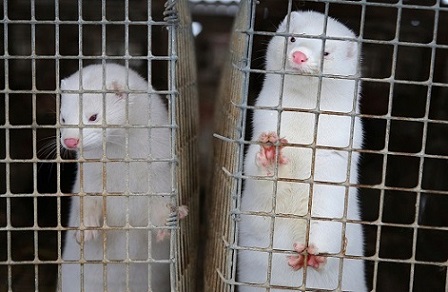COVID-19 News: Study Finds That SARS-CoV-2 Evolutionary Rate Increases During Zoonotic Infection Of Farmed Mink, Spawning Many Worrisome Mutations!
COVID-19 News: Zoonotic Infections In Minks Feb 10, 2023 2 years, 11 months, 3 days, 3 hours, 7 minutes ago
COVID-19 News: Researchers from Department of Microbiology and Immunology, The Peter Doherty Institute for Infection and Immunity at the University of Melbourne-Australia has surprisingly found that the evolutionary rate of the SARS-CoV-2 virus increases during zoonotic infection of farmed mink, spawning many worrisome mutations.

In order to investigate genetic signatures of adaptation to the mink host, the study team characterized the evolutionary rate heterogeneity in mink-associated severe acute respiratory syndrome coronaviruses (SARS-CoV-2).
In 2020, the first detected anthropozoonotic spillover event of SARS-CoV-2 occurred in mink farms throughout Europe and North America. Both spill-back of mink-associated lineages into the human population and the spread into the surrounding wildlife were reported, highlighting the potential formation of a zoonotic reservoir.
The study finding suggest that the evolutionary rate of SARS-CoV-2 underwent an episodic increase upon introduction into the mink host before returning to the normal range observed in humans. Furthermore, SARS-CoV-2 lineages could have circulated in the mink population for a month before detection, and during this period, evolutionary rate estimates were between 3 × 10–3 and 1.05 × 10–2 (95 per cent HPD, with a mean rate of 6.59 × 10–3) a four- to thirteen-fold increase compared to that in humans.
As there is evidence for unique mutational patterns within mink-associated lineages, the study explored the emergence of four mink-specific Spike protein amino acid substitutions Y453F, S1147L, F486L, and Q314K.
The study team found that mutation Y453F emerged early in multiple mink outbreaks and that mutations F486L and Q314K may co-occur.
The study findings suggest that SARS-CoV-2 undergoes a brief, but considerable, increase in evolutionary rate in response to greater selective pressures during species jumps, which may lead to the occurrence of mink-specific mutations.
The study findings emphasize the necessity of ongoing surveillance of zoonotic SARS-CoV-2 infections in the future.
The study findings were published in the peer reviewed journal: Virus Evolution.
https://academic.oup.com/ve/article/9/1/vead002/6980753
The study team assume that both host-specific mutations and an increased rate of evolution would not be unique to the introduction of SARSCoV-2 into the mink host and that this phenomenon may be seen in other novel hosts where inter-host transmission is possible.
For instance, an additional anthropozoonotic spillover event (and potential reservoir of concern) is the wild and captive white-tailed deer (Odocoileus virginianus) population in North America that were featured in various
COVID-19 News coverages and studies. A third of deer tested in Iowa, and thirty-four out of thirty-six deer tested positive at a captive cervid facility in Texas were positive for SARS-CoV-2 RNA, with evidence of deer-to-deer transmission.
8920/">https://pubmed.ncbi.nlm.nih.gov/35078920/
https://pubmed.ncbi.nlm.nih.gov/35319276/
https://pubmed.ncbi.nlm.nih.gov/35840592/
Also, SARS-CoV-2 with several mutations has been detected in white-tailed deer in Québec, Canada.
https://www.biorxiv.org/content/10.1101/2022.01.20.476458v1
Phylogenetic and epidemiological analyses have linked a possible deer-to-human transmission event with a novel, highly divergent lineage of SARS-CoV-2 detected in white-tailed deer.
https://pubmed.ncbi.nlm.nih.gov/36357713/
Though there is no direct evidence of deer-to-human transmission, a recent work has also highlighted the potential of spill-back events from infected deer populations.
https://pubmed.ncbi.nlm.nih.gov/35840592/
The adaptation of SARS-CoV-2 to the rodent host, and subsequent spill-back into the human population, could explain the emergence of divergent Omicron lineage in the late 2021.
https://pubmed.ncbi.nlm.nih.gov/34954396/
https://pubmed.ncbi.nlm.nih.gov/35005525/
https://pubmed.ncbi.nlm.nih.gov/35641567/
It has been suggested that, while adapting within a rodent host, SARS-CoV-2 accumulated mutations for approximately 12 months before re-entering the human population as the Omicron lineage with preliminary evidence for increased infectivity and higher levels of ‘vaccine-breakthrough.’
As a result of the magnitude of farmed mink populations (in both population size and geographical reach), in addition to the established transmission pathways and the ability of SARS-CoV-2 to accumulate potentially harmful mutations rapidly, zoonotic viral transmission poses a significant threat to global public health.
Furthermore, the formation of a permanent reservoir of SARS-CoV-2 in wildlife populations could lead to spill-back events of animal-adapted lineages of the virus into the human population and other susceptible animals.
The study findings emphasize the necessity of a ‘One Health’ approach to surveillance: to track any zoonotic spread of SARSCoV-2, identify outbreaks in novel hosts rapidly, and monitor the ongoing spread of SARS-CoV-2 after host-switching to prevent the establishment of a viral reservoir.
Impotantly, monitoring ‘at-risk’ animal groups is essential, including farmed and wild-living populations of minks and white-tailed deer, animals that regularly come into contact with humans.
The study team also stresses the importance of the extensive whole genome sequencing of SARS-CoV-2 isolates collected during the 2020 outbreaks in mink farms and recommend that this remains a high priority for future zoonotic spillover events of SARS-CoV-2.
For the latest
COVID-19 News, keep on logging to Thailand Medical News.
